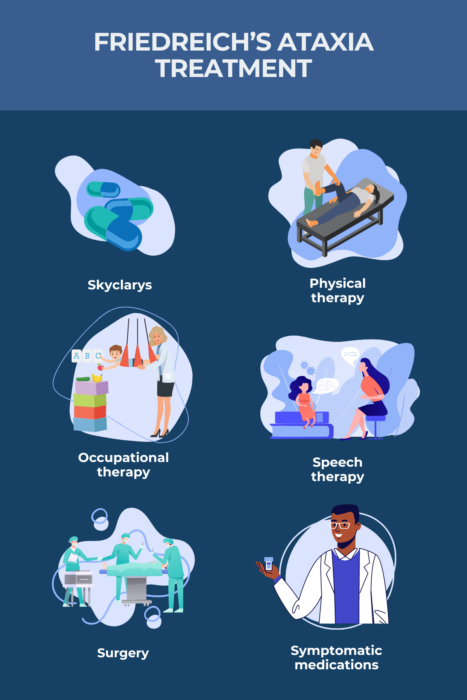Friedreich’s ataxia treatment options
Various treatments are available that can help slow the progression of Friedreich’s ataxia (FA) and manage the disease’s symptoms. However, no cure has been found to date for the progressive genetic disorder, which mainly affects the muscles and nervous system.
Physical and occupational therapies may help maintain or improve motor function in people living with FA, and speech therapy has been shown to ease problems with chewing, swallowing, and speaking. Surgery can be of benefit for some patients who experience problems with the bones of the feet or spine, and certain medications may help with other symptoms.
A new daily treatment called Skyclarys was approved in the U.S. in early 2023 to slow disease progression in FA.
Skyclarys
Skyclarys (omaveloxolone) is a once-daily oral therapy that can slow the progression of FA. The U.S. Food and Drug Administration (FDA) approved Skyclarys in February 2023 to treat FA patients ages 16 and older. A year later, the European Medicines Agency reached the same decision. It is the first therapy approved for FA.
Developed by Reata Pharmaceuticals, Skyclarys is designed to boost energy production in cells, which is impaired in FA.
The therapy became available to U.S. patients in June 2023.
Benefits
The FDA’s approval of Skyclarys was based on data from a Phase 2 study called MOXIe (NCT02255435) that showed the treatment could slow the progression of FA. Specifically, the MOXIe trial assessed disease progression using a standardized measure called the modified Friedreich’s Ataxia Rating Scale (mFARS).
The mFARS measures impairment across four domains: upper limb function, lower limb function, ability to balance while upright, and bulbar or face/throat function. Patients with greater impairment are scored higher; the maximum possible score is 93. Without treatment, mFARS scores increase (worsen) by about two points per year, though the rate of progression is notably higher among younger FA patients, particularly adolescents and children.
After about one year in the MOXIe trial, the mean mFARS score decreased by 1.55 points for patients given Skyclarys. In other words, on average, patients experienced a slight improvement in functionality in the first year after starting on the therapy.
Long-term study data showed that, after three years on Skyclarys, the mean mFARS score had increased by three points. That means that, on average, patients continued to experience some worsening of disability over the years — but the rate of progression was notably slower compared with untreated patients taking part in a natural history study.
It’s important to stress that these numbers are averages; individual patterns of disease progression and response to treatment may vary from person to person.
As Skyclarys only reached clinical testing in recent years, it’s too early to say with any certainty whether the medication may alter life expectancy for people with FA.
Physical, occupational, and speech therapy
Physical therapy, also called physiotherapy, consists of stretching and exercises that aim to maintain or improve an individual’s physical function. For people with FA, physical therapy generally focuses on helping patients with their balance, flexibility, strength, and coordination.
A therapist typically will work with a patient to develop a routine of exercises that the person can do regularly at home. Regular check-ins are used to adjust the exercises as needed based on the patient’s specific situation.
FA patients also may take part in occupational therapy. Whereas physical therapy works to improve functionality by focusing on an individual’s physical strength and flexibility, occupational therapy targets a patient’s ability to function in day-to-day life.
The goal of occupational therapy is to find or create strategies that make it easier to manage activities of daily living. For example, occupational therapists can help patients to get comfortable using mobility aids or other adaptive equipment, and they can help to set up a person’s work or home environment so it’s easier to navigate.
Speech therapy, meanwhile, focuses on improving the functionality of the mouth, jaw, and throat; it generally includes exercises to help strengthen muscles in these areas.
The focus, as the name suggests, is on improving spoken communication, typically with speech-based exercises. However, speech therapy also can include broader strategies to help patients communicate, which may include finding alternative methods of communication that aren’t reliant on the spoken word.
Benefits
Physical therapy can help patients maintain their physical functioning ability and limit physical complications of disease. It even may improve functionality for patients in some situations. The exercises done in physical therapy sessions also can help to relieve spasticity — muscle tightness and spasms — via passive stretching, in which a therapist will help a patient to stretch muscles further than the person could do alone.
Occupational therapy can help patients find strategies for maximizing their quality of life and navigating day-to-day tasks.
Speech therapy can help improve the physical function of muscles around the jaw and throat, which may help to ease problems with talking and also make it easier to chew and swallow food. Therapists trained in speech also can work with patients to develop methods of communication that aren’t reliant on spoken words, so that patients can make themselves understood even when speaking is difficult or not possible.
Surgery
Specific surgical procedures may be of benefit to patients with FA who experience severe cases of scoliosis, foot deformities, and swallowing difficulties.
Surgery for scoliosis
Scoliosis, or an abnormal sideways curvature of the spine, is a common issue in FA, affecting many patients with the disorder. If scoliosis becomes advanced — a very pronounced curve, causing functional issues like difficulty sitting, trouble keeping the head centered above the pelvis, or problems breathing — surgery may be warranted for some FA patients to help correct the curvature. Spinal braces, which help support the spine and keep it aligned, also may be used to help manage scoliosis in FA and delay the need for surgical correction.
Foot deformity surgeries
People with FA are at risk of developing deformities of the feet, such as pes cavus, an abnormally high foot arch, or talipes equinovarus, commonly called clubfoot, in which the foot points downward and inward. If these issues become advanced, surgery may be needed to help correct the deformity.
Feeding tube placement
FA can cause weakness and coordination problems in the muscles of the mouth and throat, which can make it difficult or impossible for patients to get enough nutrition eating by mouth. In such cases, a surgical procedure may be necessary to place a feeding tube, which can deliver nutrients directly into the stomach. Such tubes may be inserted through the nose — called a nasogastric tube — or through the side of the belly, known as a gastrostomy tube.
Benefits
Surgeries for scoliosis or foot deformities can help patients to maintain their comfort and maximize their physical functionality, while feeding tube placement can be used to help patients get adequate nutrition.

Additional medications and therapies
Other medications and therapies can be of benefit to FA patients and help relieve or at least address some of the disease’s symptoms, including spasticity and heart problems.
Treatments for spasticity
Several medications are available that can help relieve spasticity among people with FA. These include:
- tizanidine (alternatively spelt tizanadine), an oral therapy usually taken two or three times per day
- gabapentin, an oral medication usually taken three times per day
- baclofen, a medication that may be taken by mouth or administered intrathecally, or though the spine, using a pump
- botulinum toxin, an injection therapy given into affected muscles.
Devices such as splints or casts also may be used to help stretch the muscles and relieve spasticity.
Treatments for overactive bladder
Overactive bladder, a common complaint in FA, may be treated with daily oral medications that work to reduce muscle contractions around the bladder. These medicines include oxybutynin, tolterodine, and solifenacin.
For some patients, injection into the bladder muscles with botulinum may be helpful for relieving an overactive bladder.
Catheterization also can help to ease this symptom. In this procedure, a tube is inserted through the urethra to drain the bladder, either as needed or permanently.
Treatments for sleep apnea
People with FA are at increased risk for obstructive sleep apnea, a sleep disorder in which a person will temporarily stop breathing during sleep because the airways close. For patients who develop sleep apnea, a continuous positive airway pressure (CPAP) device can be used to help keep the airways open during sleep.
Treatments for diabetes
Diabetes is relatively common among people with FA. In addition to dietary changes, diabetes in FA can be managed via treatment with insulin. Other medications that can help boost insulin activity and lower blood sugar, such as incretin analogues, also may be used in some cases to manage FA-related diabetes.
Treatments for heart problems
Cardiac involvement in FA usually manifests as hypertrophic cardiomyopathy, or simply put, an enlarged heart. Heart failure — where the heart is unable to adequately pump blood out to the body — is common among people with FA. There isn’t much formal research on treatment of heart failure in FA specifically; management of this symptom for people with the disorder generally follows guidelines for heart failure in the general population.
Treatment of heart failure in FA typically involves angiotensin-converting enzyme (ACE) inhibitors or angiotensin receptor blockers, which are medications that can relax the blood vessels to make it easier for the heart to pump blood. Examples include captopril, enalopril, and valsartan.
Beta blockers are a class of medication that can slow heart rate and decrease the force of heart contractions. These therapies are commonly used to treat non-FA heart failure, but they can be harmful in FA patients due to the loss of contractile fibers in the heart muscle.
Abnormal heart rhythms, called arrhythmias, also can occur in FA patients. These may be treated with oral medications that can help regulate heart rhythm. Digoxin, amiodarone, or flecainide are examples of available medicines. Implanted devices such as pacemakers also may be used to regulate heart rhythms in people with FA.
Benefits
The range of therapies that are available to manage FA’s signs and symptoms can help to minimize the impact these symptoms have on day-to-day life and reduce the risk of developing more serious complications.
Experimental therapies
A number of experimental treatments for FA are now in clinical development:
- CTI-1601, an under-the-skin (subcutaneous) injection therapy from Larimar Therapeutics, is designed to deliver a functional version of the frataxin protein to the body’s cells. It’s now in testing in a Phase 2 clinical trial.
- Supplements of nicotinamide, or vitamin B3, would provide the body with a nutrient important for energy production. The treatment is now being tested in FA clinical trials.
- Vatiquinone, also known as PTC-743, is an oral therapy designed by PTC Therapeutics to reduce inflammation and nerve damage in FA patients. It was found to slow disease progression after 1.5 years in children and adults with FA taking part in a Phase 2/3 clinical trial.
- DT-126, Design Therapeutics’ approach for boosting the activity of the FXN gene whose defect causes Friedrich’s ataxia, showed promising results in an early Phase 1 study. The treatment is now being evaluated in further Phase 1 testing.
- Resveratrol, an antioxidant, is a natural compound found in peanuts, blueberries, and the skin of the skin of red grapes, among other sources. It’s being tested in a Phase 2 trial involving FA patients.
- Gene therapies are designed to deliver a healthy version of the FXN gene to the body’s cells. One example is Lexeo Therapeutics’ gene therapy candidate LX2006, which is being tested in a Phase 1/2 trial.
Lifestyle changes
Diet
Certain dietary modifications may be helpful for managing FA. In particular, diabetes is a common complication of FA, and dietary changes are crucial for managing this condition. Dietary modifications for diabetic patients generally aim to reduce the total amount of calories consumed, with a particular focus on cutting out excess sugars, while still ensuring patients get all the nutrients they need to keep their body healthy.
FA patients also are advised to eat a diet high in fiber, and to include proteins, fats, unsweetened fruits, starchy vegetables, and pasta. It’s important for patients to be sure to drink plenty of liquids. Processed meats should be avoided.
Some dietary modifications also may be helpful for patients who have difficulty chewing or swallowing. Finding foods that are softer and easier to chew, or that can be chopped or pureed to make swallowing easier, is often a key part of dietary management for people with these symptoms.
Exercise
Getting regular physical exercise can help patients to maintain or improve their motor function, coordination, and balance. In addition to helping strengthen muscles, exercise can be helpful for easing fatigue in people with FA. A physical therapist usually will work with a patient to develop a specific exercise regimen that works for that individual. The National Ataxia Foundation also offers online resources, with exercises that may be helpful for people with ataxia.
Meditation and mindfulness practices may benefit some FA patients.
Managing hearing problems
Many people with FA experience issues with hearing — specifically, it’s common for patients to have difficulty focusing on a specific sound and tuning out background noise. The ability to detect sound is typically not affected in FA, however, so conventional hearing aids are not usually very helpful for patients. But FM or frequency modulated systems, which help to filter out background noise, may help improve hearing ability for people with FA.
Support
A range of support services and other resources are available for people with FA — from programs offered by national advocacy organizations to local groups to online support. Patients also may check with their healthcare team to ask for referrals to such groups.
The Friedreich’s Ataxia Research Alliance, known as FARA, offers a range of resources and support for people with an FA diagnosis and their families. Among them are educational materials and information relating to school, work, travel, and accessing disability benefits.
The Friedreich’s Ataxia Parents Group, or FAPG, is an online support group that connects parents and guardians of children with FA and other childhood ataxias.
The National Ataxia Foundation offers support groups for people with FA and other forms of ataxia. In-person groups meet in most U.S. states, and a range of online support groups also are available.
Friedreich’s Ataxia News also offers several resources that may help provide support and connection for people living with FA. There are various columns in which patients discuss their own experiences, as well as forums where people in the FA community can connect with each other.
Mental health
Living with a chronic illness like FA can take a toll on a person’s mental and emotional well-being, and it’s important to manage these aspects of the disease in addition to its physical manifestations. Counseling and talk therapy is helpful for many patients; pharmacological therapies (e.g., antidepressants or anti-anxiety medications) also may be helpful. Some patients also benefit from mindfulness and meditation — techniques that aim to bring a person’s focus to the present moment, setting aside worries and concerns about the future.
Friedreich’s Ataxia News is strictly a news and information website about the disease. It does not provide medical advice, diagnosis, or treatment. This content is not intended to be a substitute for professional medical advice, diagnosis, or treatment. Always seek the advice of your physician or other qualified health provider with any questions you may have regarding a medical condition. Never disregard professional medical advice or delay in seeking it because of something you have read on this website.
Recent Posts
- Toward a new understanding of positivity and hope
- New tool tracks hidden symptoms in people with Friedreich’s ataxia
- A gift-giving guide for those who have a loved one with FA
- My FA diagnosis left me ‘thoroughly shaken,’ but I’ve found my resolve
- New MRI approach using AI may offer better picture of FA changes
FAQs about Friedreich's ataxia treatment
Skyclarys (omaveloxolone) is the first therapy ever to be approved by the U.S. Food and Drug Administration (FDA) to treat Friedreich’s ataxia. Although Skyclarys is not a cure for the genetic disorder, the once-daily oral therapy has been proven to slow the progression of the disease in clinical trials.
Although there is no cure for Friedreich’s ataxia, a range of therapies are available that can help to ease symptoms, slow disease progression, and maintain to a certain extent a person’s functionality. In terms of medication, Skyclarys (omaveloxolone) is the only specific Friedreich’s ataxia therapy approved in the U.S.
Insurance policy coverage varies depending on the specific insurer and plan. It’s recommended that people with Friedreich’s ataxia consult with their specific insurance provider to understand what forms of coverage are available for them. In the case of Skyclarys (omaveloxolone), the first and currently only therapy approved for Friedreich’s ataxia in the U.S., the treatment’s developer, Reata Pharmaceuticals, offers support for those prescribed one of their medicines, regardless of insurance status.
Lifestyle changes cannot eliminate Friedreich’s ataxia (FA) symptoms or prevent disease progression, but some alterations in day-to-day living may be helpful; for example, regular physical exercise can help patients maintain their motor function and ease fatigue. Dietary modifications may be helpful for patients who have difficulty chewing or swallowing, and also are important for managing disease complications like diabetes. Many people with FA also benefit from the use of adaptive equipment or changes to their environment that can make daily life with the disease easier to navigate.
Related Articles

 Fact-checked by
Fact-checked by 



